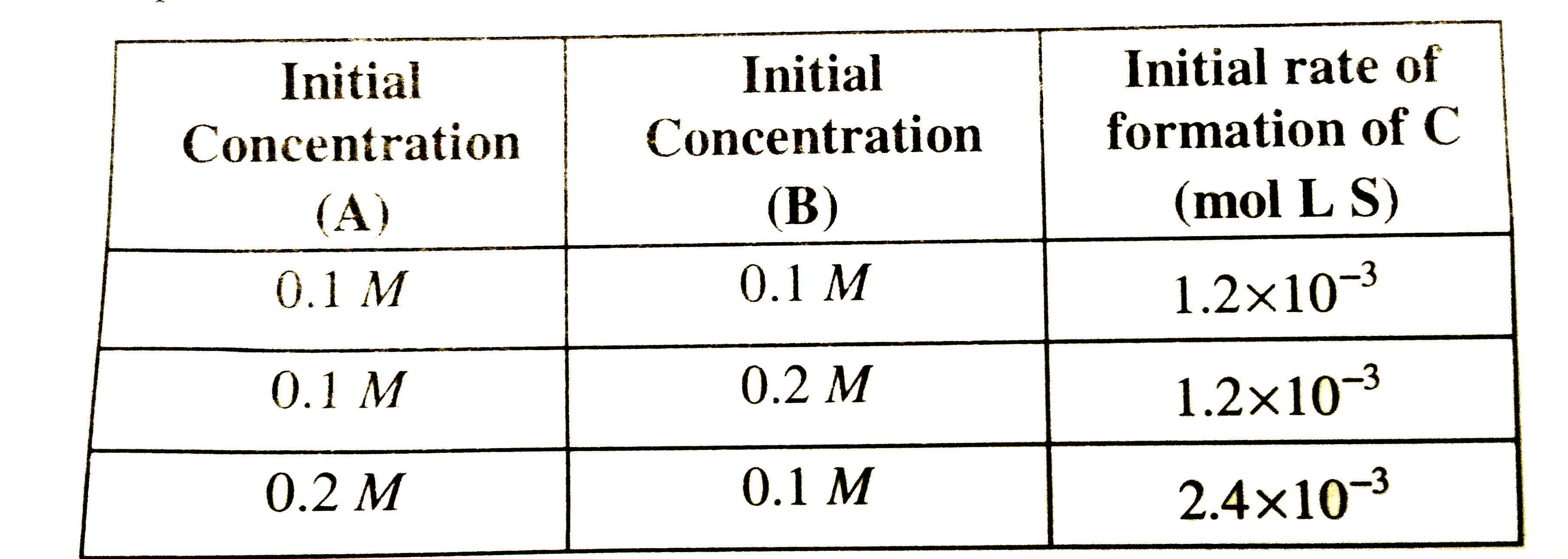For the non-stoichiometric reaction 2A+B→C+D, The following data were obtained in three separate experiments, all at 298 K.

The rate law for the formation of C is:
dcdt=k[A][B]
dcdt=k[A]2[B]
dcdt=k[A][B]2
dcdt=k[A]
The correct Answer is:D
Let rate of reaction =d[C]t=k[A]x[B]y
Now from the given data
1.2×10−3=k[0.1]x[0.1]y ...(i)
1.2×10−3=[0.1]x[0.2]y ...(ii)
2.4×10−3=[0.2]x[0.1]y ...(iii)
Dividing equation (i) by (ii)
⇒1.2×10−31.2×10−3=k[0.1]x[0.1]yk[0.1]x[0.2]y
We find, y = 0
Now dividing equation (i) by (iii) ⇒1.2×10−32.4×10−3=k[0.1]x[0.1]yk[0.2]x[0.1]y
We find, x = 1
Hence d[C]dt=k[A]1[B]0
Topper's Solved these Questions
- CHEMICAL KINETICS BOOK - DISHA PUBLICATIONCHAPTER - CHEMICAL KINETICS EXERCISE - EXERCISE 1 : CONCEPT BUILDER (TOPICWISE) (TOPIC 1: Rate of Reaction, Rate Laws and Rate Constant)
11 Videos
- CHEMICAL KINETICS BOOK - DISHA PUBLICATIONCHAPTER - CHEMICAL KINETICS EXERCISE - EXERCISE 1 : CONCEPT BUILDER (TOPICWISE) (TOPIC 2: Order of Reaction and Half Life Period)
32 Videos
- CHEMICAL BONDING AND MOLECULAR STRUCTURE BOOK - DISHA PUBLICATIONCHAPTER - CHEMICAL BONDING AND MOLECULAR STRUCTURE EXERCISE - EXERCISE-2: CONCEPT APPLICATOR
30 Videos
- CHEMISTRY IN EVERDAY LIFE BOOK - DISHA PUBLICATIONCHAPTER - CHEMISTRY IN EVERDAY LIFE EXERCISE - Exercise
88 Videos
Similar Questions
For the non – stoichiometre reaction 2A+B→C+D , the following kinetic data were obtained in three separate experiments, all at 298 K

The rate law for the formation of C is:
View SolutionFor the non-stoichiometre reaction 2A+B→C+D , the following kinetic data were obtained in three separate experiments , all at 298 K

The rate law for the formation of C is
View Solution
Knowledge Check
For the non-stoichiometric reaction:
2A+B→C+D, the following kinetic data were obtained in three separate experiments, all 298 K

The rate law for the formation of C is:AdCdt=k[A]BdCdt=k[A][B]CdCdt=k[A]2[B]DdCdt=k[A][B]2For the non-stoichiometric reaction 2A+B→C+D, The following data were obtained in three separate experiments, all at 298 K.

The rate law for the formation of C is:Adcdt=k[A][B]Bdcdt=k[A]2[B]Cdcdt=k[A][B]2Ddcdt=k[A]For the non-stoichiometric reaction 2A+B→C+D
The following kinetic data were obtained in theee separate experiment, all at 98K
∣∣ ∣ ∣ ∣ ∣∣Initial concentration (A)Initial concentration (B)Initial rate of formation of C(molL−1s−1)0.01M0.1M1.2×10−30.1M0.2M1.2×10−30.2M0.1M2.4×10−3∣∣ ∣ ∣ ∣ ∣∣
The rate law for the formation of C is:Adcdt=K[A][B]2Bdcdt=k[A]Cdcdt=k[A][B]Ddcdt=k[A]2[B]
For the non-stoichiometric reaction 2A+B→C+D, The following data were obtained in three separate experiments, all at 298 K.

The rate law for the formation of C is:
View SolutionFor the non-stoichiometric reaction:
A+B→C+D, the following kinetic data were obtained in three separate experiments, all at 298K.

The order of the reaction is.
View SolutionFor the given reaction, A+B→ Products following data were obtained

(i) Write the rate law expression.
(ii) Find the rate constant.
View SolutionFor the reaction
A+2B→2C
the rate law for the formation of C is
View SolutionIn the reaction a+3B→2C, the rate of formation of C is
View Solution
